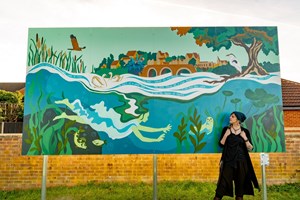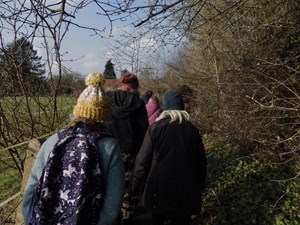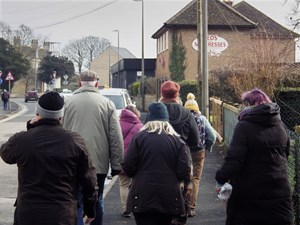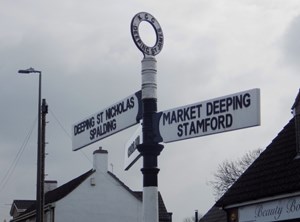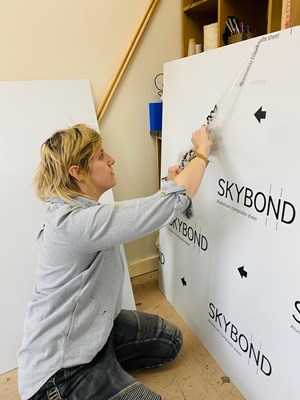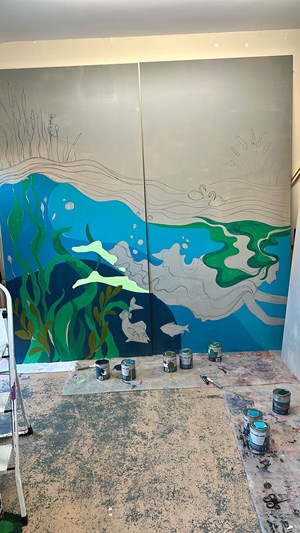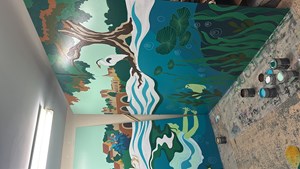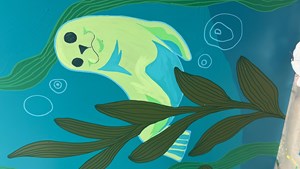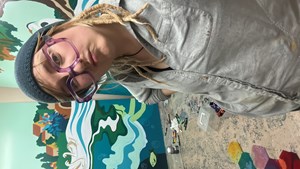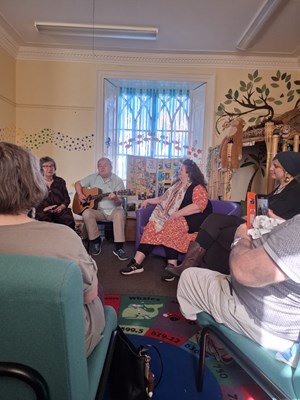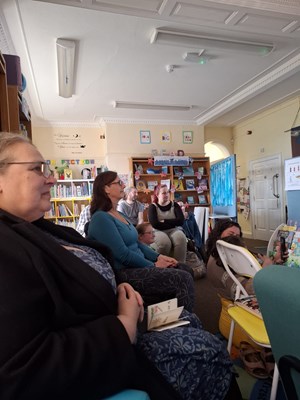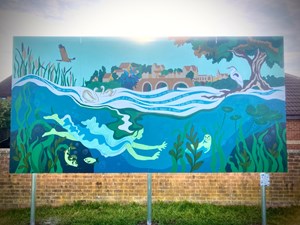- Home
- Projects
- Our Place Our Art
- Deepings

Our Place, Our Art
Deep Place
THE DEEP PLACES - about the mural
Artist and storyteller Rose Croft hosted events in Deeping to explore its deep connections. Through zine-making, river walks and story circles, she gathered local stories and wove them into a new fairytale created for Deeping. This story inspired a mural now installed in Jubilee Park, rich with shared experiences and everyday details.
'The Deep Places' celebrates the power of storytelling in shaping collective identity, keeping community voices visible in the landscape.
The mural was shaped by the reflections and experiences shared by the community, this fairytale weaves together local folklore, memories, and a deep connection to the land. At the heart of both the mural and the community is the river, flowing through the artwork just as it runs through Deeping itself, connecting people, places, and stories.
Each element in the mural reflects part of this shared story. But what do they represent?
Here, Rose shares the meaning behind the mural....
Themes of the Story
Across the many conversations I had during my residency through feedback sessions, casual chats and shared cups of tea one theme came through again and again. Deeping is a place people feel deeply connected to. Many residents spoke of having lived here their whole lives and while they expressed pride in the area there was also a quiet longing for the sense of community they remember from the past.
One woman told me that when she was younger she used be proud to know every single person in the town by name. Another shared that her mother never thought to lock her front door as it was well known that people were welcome to stop by and make themselves a cup of tea in her kitchen even if she wasn’t in. These stories paint a picture of a different kind of closeness; one built on trust and familiarity.
We’re all a bit more aware these days of how modern life pulls us apart. Capitalism and the fast pace of daily life can make this a lonely time to be alive. But throughout my time in Deeping I felt something different. I saw small strong signs of togetherness. Local walking groups, community events, places to sit for tea and conversation and a warm feeling of welcome in the cafés and pubs near the river. There was still a strong current of care running through the town.
That’s why the theme of community felt so central to the story. The river itself became a symbol of this connection. Historically the Welland was tidal and played a key role in the town’s economy with many businesses relying on its waters. While that has changed over time the river is still a central feature in the landscape and in local life. It flows quietly through Deeping linking past and present, people and place just like the stories that shaped this mural.
The Mural’s Colour Scheme
The mural uses a limited colour palette to show the contrast between two worlds: the mysterious blues and greens beneath the water’s surface and the warm oranges and yellows of the world above. Each animal contains a touch of both, suggesting the way the two worlds connect and overlap.
Handwritten Words
Some lines from the story appear on the mural in my own handwriting. I deliberately avoided typography, as the story was written by hand and this personal touch connects the artwork to its creator. It gives the mural a more intimate and human feel.
Bubbles in the Sky
You might notice bubbles rising through the sky. This element emphasises the connection between the river and the community, and is a nod to conversations I had with residents during making sessions about the vast and beautiful Fen skies seen in Deeping.
The Ghostly River’s Daughter
No folk story feels complete without a ghost or two. I was curious about local ghost stories and heard some brilliant ones from the Deeping youth group. I shared some of my favourite Fen ghost tales too. I knew I wanted to include a ghost in my story but not a frightening one. Instead I created a helping spirit, a gentle presence that watches over the river.
As I gathered stories from the Deeping community one thing stood out. Almost every ghost story I heard was about a woman. There were tales of the Grey Lady, girls appearing in mirrors, young women spotted on quiet roads stopping cars and others said to haunt family homes. The ferryman’s daughter grew from an amalgamation of all these stories.
She isn’t a frightening figure but a quiet guardian of the river. A little mysterious, a little magical and rooted in the landscape. The dappled pattern on her skin represents the light on the surface of the water, dancing and shifting with movement. She belongs to the river in the same way the memories do.
The Hidden Archway
Tucked away among the painted houses is a tiny round archway, almost hidden. This is a nod to the large archways found in Market Deeping town centre, once used for horse and carriages. They’re part of the area’s architectural character and history.
The Bridge
There are several bridges over the Welland in Deeping but the one in the mural is inspired by the bridge in Deeping St James. We crossed it on a river walk during my residency and I heard many stories about it. People spoke about jumping off it into the water, fishing from it and playing pooh sticks. It’s picturesque and central to many memories, forming a lovely backdrop for the town.
Church and Graveyard
I spent time at a tea and cake morning at the Priory Church during my residency and heard many cherished memories from lifelong Deeping residents as well as enjoying a long conversation with the vicar. Many people spoke about having lived in the area all their lives, with generations of family buried in the graveyard. This felt like a strong and deeply rooted connection to place, where memory and presence sit side by side.
I often walked through the churchyard during this project, reading grave markers and enjoying the peace. It offered a quiet space for reflection. At night the whole area is lit beautifully. After a couple of Friday evening sessions with the Deeping youth group, I walked home through the graveyard and found it both comforting and calm. Those gentle walks helped me feel more grounded in the place.
One of the church wardens shared a ghostly experience he’d had when alone in the church, hearing a great whoosh of sound pass from one side of the building to the other with no clear explanation.
The most memorable ghost story I heard came from Nancy, a remarkable woman who had has 106 year old. She was well known and much loved in the area, and as I began gathering stories, several people encouraged me to speak with her. I’m so glad I did. She had a sharp wit and a warm, gracious way about her, making space for everyone in the conversation, even those who struggled to engage due to cognitive decline.
Nancy recalled walking through the Priory graveyard as a young girl with two friends when a shadowy figure in a wide-brimmed hat passed them. When they turned to look, he had vanished. Later, she learned they had likely seen Reverend John George, a former vicar known for walking that same path in life and, it seems, still in death.
Nancy passed away the same day I finished painting the mural. I’m sorry I didn’t get to share my story with her, as I’d promised I would. I think she would have liked it.
The Oak Tree
The tree in the mural is inspired by the large oak outside the Priory Church in the car park area. It’s a tree that has stood for generations and has faced moments of threat or uncertainty. Planted in 1841, and known as the Prince of Wales Oak, the tree is over 180 years old. Oak trees symbolise strength, life and endurance. They also serve as a powerful metaphor for thriving ecosystems and resilient communities. I painted a small hole at the base of the tree in the mural to reflect the real hollow in its trunk.
Buddleia Plant
The only blue element above the waterline, apart from the sky is the buddleia. Its colours are the same deep blues as the river plants below, tying it to the underwater world. In the story that inspired the mural, the buddleia is planted by the river’s daughter, further linking it to the watery realm. I chose to include buddleia not only for its beauty and symbolism but because of its connection to Deeping. The plant is named after Adam Buddle, a local botanist and clergyman born in 1662 in Deeping St James. He was a respected naturalist, and though the plant wasn’t named after him until after his death, his legacy lives on in its name.
Fishes In The Water
During my residency I spoke to many people who remembered fishing in the river, often with parents or grandparents. These memories were warm and vivid, and the pike became a symbol of those shared moments spent by the water.
The Heron
Many birds live along the Welland but one heron in particular has become something of a local character. Several people mentioned him and he’s affectionately known as The General. He’s often seen along the riverbank and brings quiet joy to those who spot him. Including him was a way to celebrate the simple yet powerful connection people have with the local wildlife.
Otters
Otters live along the River Welland and several people shared stories of seeing them, usually early in the morning or in quieter spots along the banks. They’re shy and quick but occasionally someone’s lucky enough to spot one paused on the river’s edge or gliding through the water. Some residents have even captured photos, proud to have caught a glimpse of such an elusive creature.
The Seal
While I was gathering stories, a few people mentioned seeing seals in the river. There have been rare confirmed sightings, but I suspect some of those reports may have actually been otters. There’s something quite joyful about that mix-up; a sign of how closely people are watching the water and how magical the river feels when something unexpected appears. I chose to include a seal instead of an otter in this mural as it felt more unexpected and magic.
Marsh Harrier
Although I considered painting a long-eared owl after seeing so many beautiful photos in local nature watch groups, I chose the marsh harrier instead. Almost every time I was in Deeping I spotted one and it was a favourite among several residents I spoke to. Marsh harriers are birds of prey that nest in reed beds and are a conservation success story. They are often seen around Deeping Lakes and their graceful presence adds to the richness of the area’s natural life.
The Swans
Swans were spoken about with great fondness. They’re hard to miss and even harder not to enjoy watching. Many people shared stories about seeing cygnets grow up over the seasons, being hissed at by protective parents or simply watching swans glide across the water. Every river needs a swan or two, and the Welland is no exception.
From our What’s On section...
-
Joseph Beech and Andrew Forbes
Wed 14 Jan 2026
Joseph Beech became Sub-Organist of Durham Cathedral in Sept...
-
Rhinestone Cowboy: The Glen Campbel...
Sat 17 Jan 2026
From his humble beginnings to his meteoric rise to fame, and...
-
Disco Toddlers 2026
Mon 19 Jan , Mon 16 Feb , Mon 16 Mar & Mon 13 Apr 2026
Join us in our beautiful Ballroom and spark joy in your todd...
-
Hauntings
Fri 23 Jan 2026
Performed by GERARD LOGAN (Olivier Nominee & Winner of The Stage Newspaper’s ‘Best Solo...

